|
Paper Image
| |
Conference Information
|
Google Scholar
|
Publication Date
|
| |
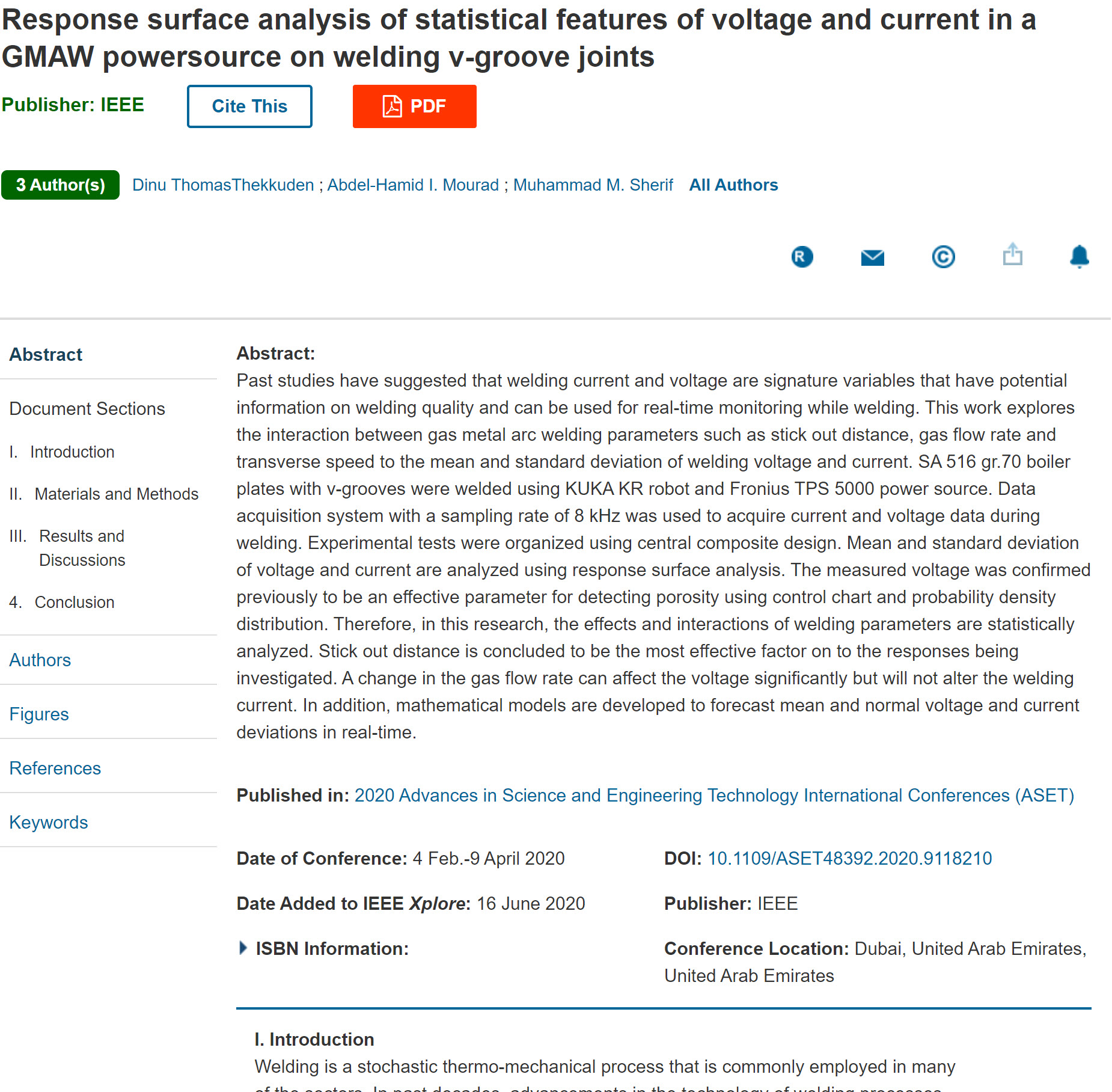
| |
Response surface analysis of statistical features of voltage and current in a GMAW powersource on welding v-groove joints
Dinu ThomasThekkuden, Abdel-Hamid I. Mourad, Muhammad M. Sherif*
Past studies have suggested that welding current and voltage are signature variables that have potential information on welding quality and can be used for real-time monitoring while welding. This work explores the interaction between gas metal arc welding parameters such as stick out distance, gas flow rate and transverse speed to the mean and standard deviation of welding voltage and current. SA 516 gr.70 boiler plates with v-grooves were welded using KUKA KR robot and Fronius TPS 5000 power source. Data acquisition system with a sampling rate of 8 kHz was used to acquire current and voltage data during welding. Experimental tests were organized using central composite design. Mean and standard deviation of voltage and current are analyzed using response surface analysis. The measured voltage was confirmed previously to be an effective parameter for detecting porosity using control chart and probability density distribution. Therefore, in this research, the effects and interactions of… Details
|
6
|
06 Jun 2020
|   |
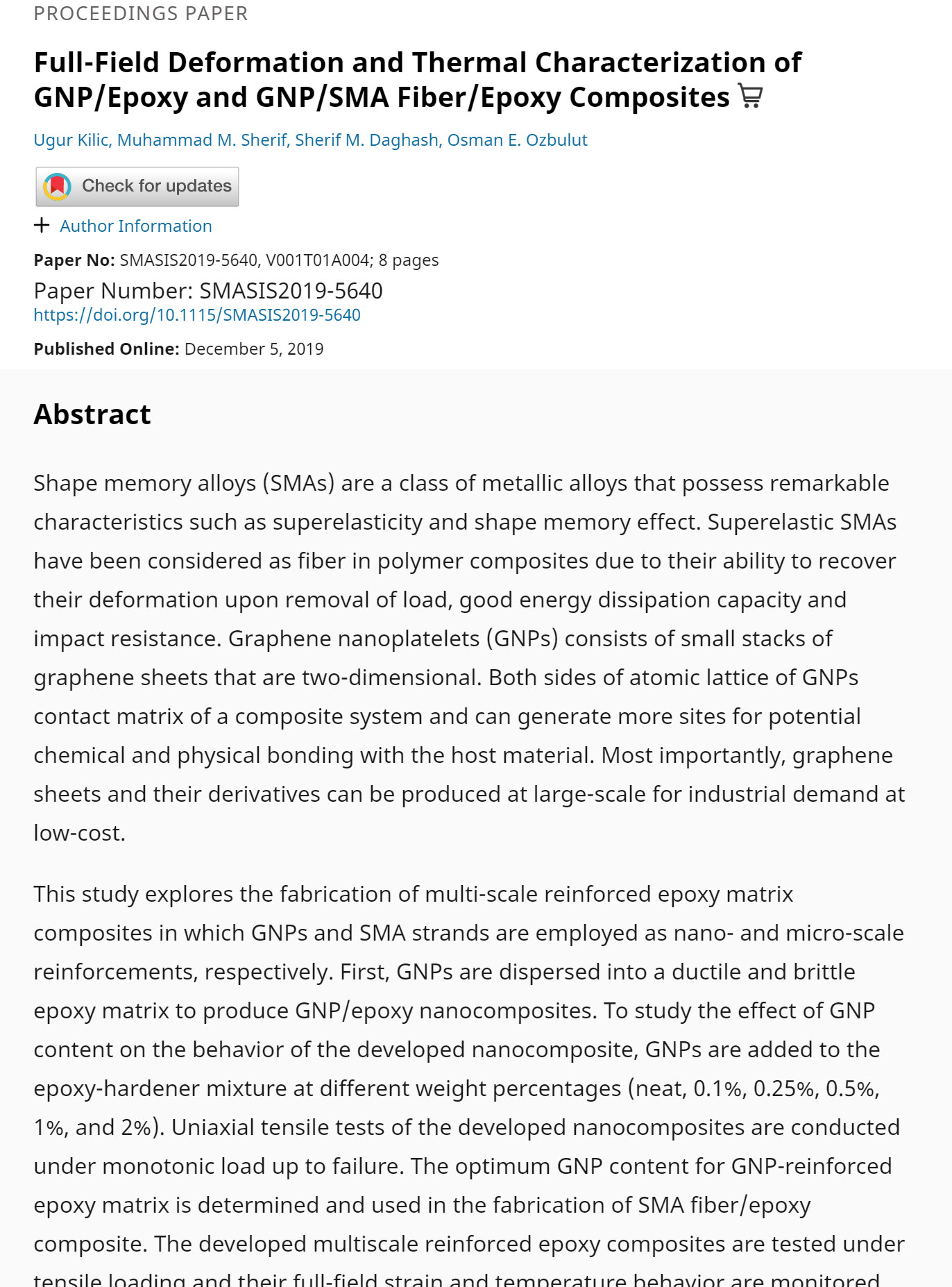
| |
Full-Field Deformation and Thermal Characterization of GNP/Epoxy and GNP/SMA Fiber/Epoxy Composites
Ugur Kilic, Muhammad M. Sherif*, Sherif M. Daghash, Osman E. Ozbulut
Shape memory alloys (SMAs) are a class of metallic alloys that possess remarkable characteristics such as superelasticity and shape memory effect. Superelastic SMAs have been considered as fiber in polymer composites due to their ability to recover their deformation upon removal of load, good energy dissipation capacity and impact resistance. Graphene nanoplatelets (GNPs) consists of small stacks of graphene sheets that are two-dimensional. Both sides of atomic lattice of GNPs contact matrix of a composite system and can generate more sites for potential chemical and physical bonding with the host material. Most importantly, graphene sheets and their derivatives can be produced at large-scale for industrial demand at low-cost. Details
|
|
05 Dec 2019
|   |
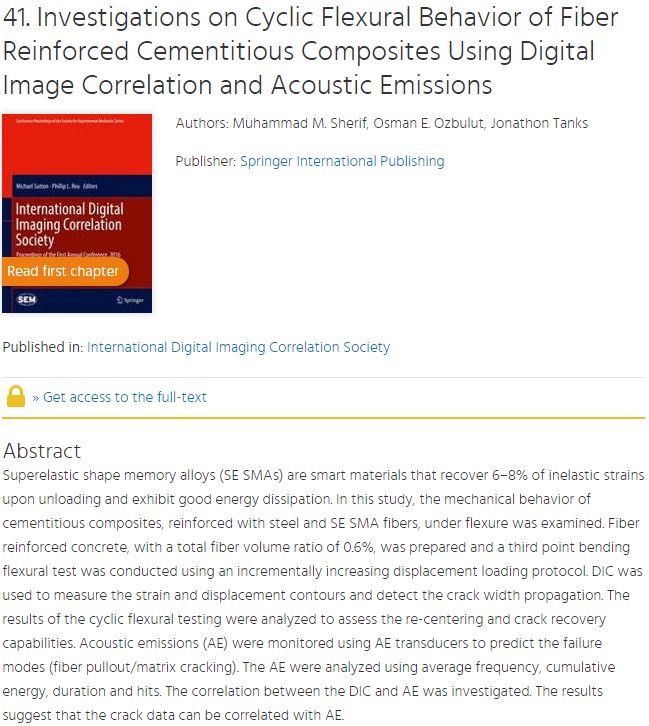
| |
Investigations on Cyclic Flexural Behavior of Fiber Reinforced Cementitious Composites using Digital Image Correlation and Acoustic Emissions
M. Sherif*, O.E. Ozbulut, J. Tanks
Superelastic shape memory alloys (SE SMAs) are smart materials that recover 6–8% of inelastic strains upon unloading and exhibit good energy dissipation. In this study, the mechanical behavior of cementitious composites, reinforced with steel and SE SMA fibers, under flexure was examined. Fiber reinforced concrete, with a total fiber volume ratio of 0.6%, was prepared and a third point bending flexural test was conducted using an incrementally increasing displacement loading protocol. DIC was used to measure the strain and displacement contours and detect the crack width propagation. The results of the cyclic flexural testing were analyzed to assess the re-centering and crack recovery capabilities. Acoustic emissions (AE) were monitored using AE transducers to predict the failure modes (fiber pullout/matrix cracking). The AE were analyzed using average frequency, cumulative energy, duration and hits. The correlation between the DIC and AE was investigated. The results suggest that the … Details
|
|
31 Mar 2017
|   |
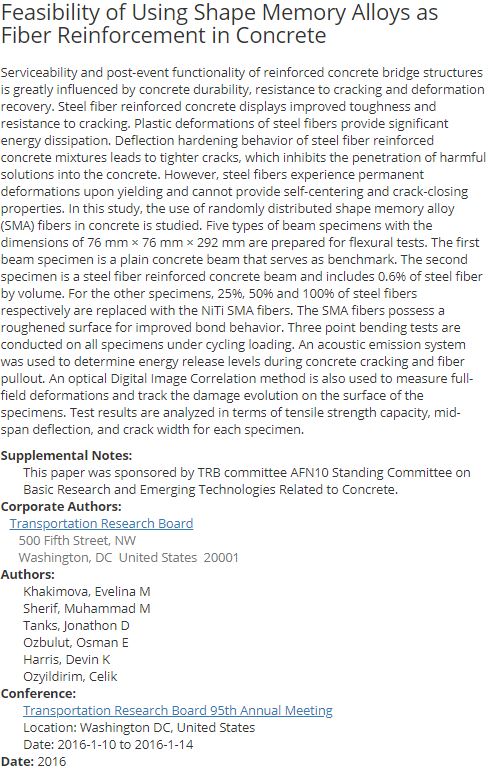
| |
Feasibility of using Shape Memory Alloys as Fiber Reinforcement in Concrete
Evelina M Khakimova, Muhammad M. Sherif*, Jonathon D Tanks, Osman E Ozbulut, Devin K Harris, Celik Ozyildirim
Serviceability and post-event functionality of reinforced concrete bridge structures is greatly influenced by concrete durability, resistance to cracking and deformation recovery. Steel fiber reinforced concrete displays improved toughness and resistance to cracking. Plastic deformations of steel fibers provide significant energy dissipation. Deflection hardening behavior of steel fiber reinforced concrete mixtures leads to tighter cracks, which inhibits the penetration of harmful solutions into the concrete. However, steel fibers experience permanent deformations upon yielding and cannot provide self-centering and crack-closing properties. In this study, the use of randomly distributed shape memory alloy (SMA) fibers in concrete is studied. Five types of beam specimens with the dimensions of 76 mm × 76 mm × 292 mm are prepared for flexural tests. The first beam specimen is a plain concrete beam that serves as benchmark. The second specimen is a steel fiber reinforced concrete beam and… Details
|
|
13 Jan 2016
|   |

| |
Experimental Characterization of Shape Memory Alloy Cables for Applications in Civil Structures
O.E. Ozbulut, S. Daghash, M. Sherif*
“Experimental Characterization of Shape Memory Alloy Cables for Applications in Civil Structures”, 3rd Conference on Smart Monitoring and Rehabilitation of Civil Structures, Antalya, Turkey, September 7 - 9, 2015. Details
|
|
08 Sep 2015
|   |
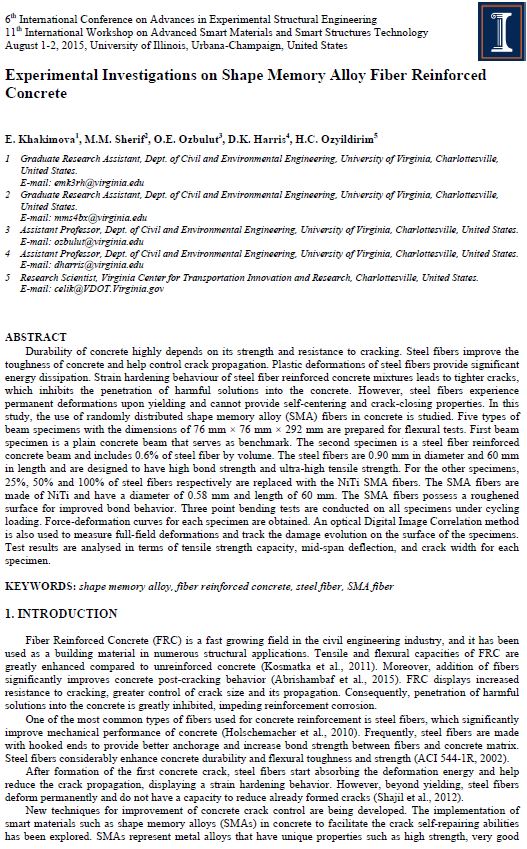
| |
Experimental Investigations on Shape Memory Alloy Fiber Reinforced Concrete
E. Khakimova, M.M. Sherif*, O.E. Ozbulut, D.K. Harris, H.C. Ozyildirim
Durability of concrete highly depends on its strength and resistance to cracking. Steel fibers improve the toughness of concrete and help control crack propagation. Plastic deformations of steel fibers provide significant energy dissipation. Strain hardening behaviour of steel fiber reinforced concrete mixtures leads to tighter cracks, which inhibits the penetration of harmful solutions into the concrete. However, steel fibers experience permanent deformations upon yielding and cannot provide self-centering and crack-closing properties. In this study, the use of randomly distributed shape memory alloy (SMA) fibers in concrete is studied. Five types of beam specimens with the dimensions of 76 mm × 76 mm × 292 mm are prepared for flexural tests. First beam specimen is a plain concrete beam that serves as benchmark. The second specimen is a steel fiber reinforced concrete beam and includes 0.6% of steel fiber by volume. The steel fibers are 0.90 mm in diameter and 60 mm in length and are … Details
|
11
|
02 Aug 2015
|   |
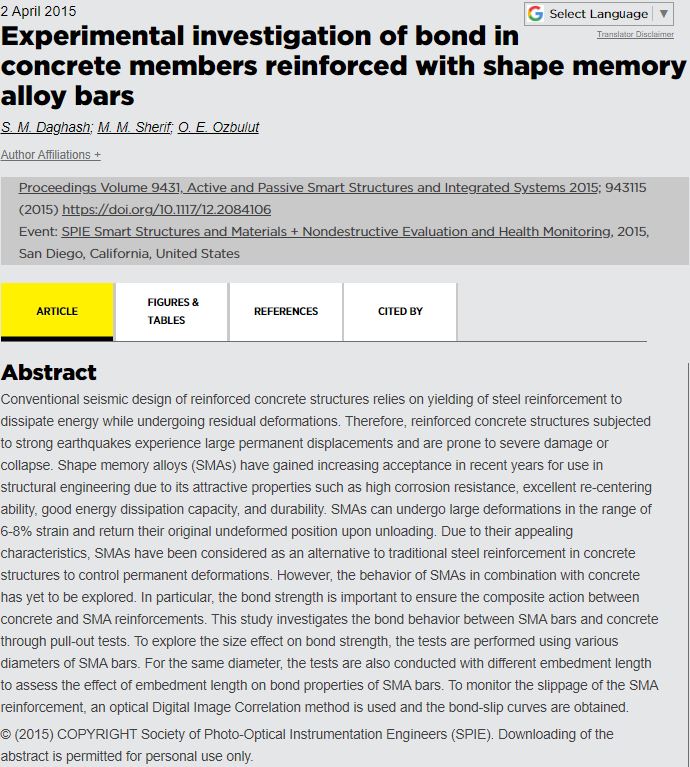
| |
Experimental Investigation of Bond in Concrete Members Reinforced with Shape Memory Alloy Bars
SM Daghash, MM Sherif*, OE Ozbulut
Conventional seismic design of reinforced concrete structures relies on yielding of steel reinforcement to dissipate energy while undergoing residual deformations. Therefore, reinforced concrete structures subjected to strong earthquakes experience large permanent displacements and are prone to severe damage or collapse. Shape memory alloys (SMAs) have gained increasing acceptance in recent years for use in structural engineering due to its attractive properties such as high corrosion resistance, excellent re-centering ability, good energy dissipation capacity, and durability. SMAs can undergo large deformations in the range of 6-8% strain and return their original undeformed position upon unloading. Due to their appealing characteristics, SMAs have been considered as an alternative to traditional steel reinforcement in concrete structures to control permanent deformations. However, the behavior of SMAs in combination with concrete has yet to be explored. In particular, the bond strength… Details
|
2
|
02 Apr 2015
|   |
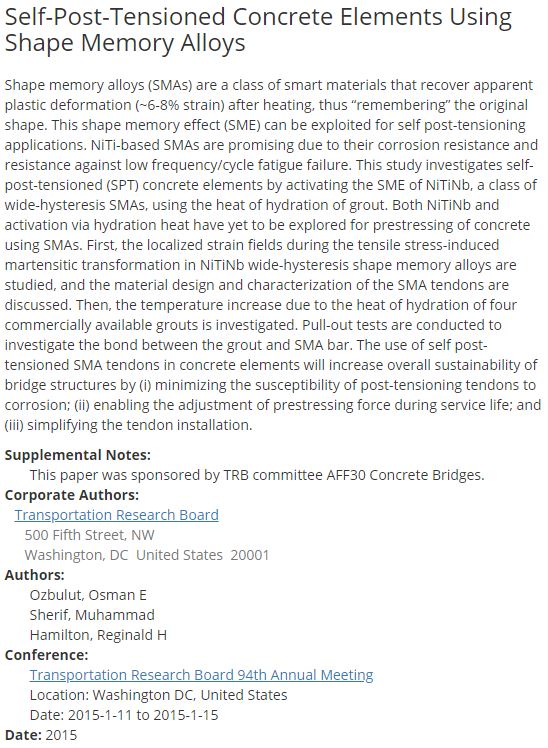
| |
Self-Post-Tensioned Concrete Elements Using Shape Memory Alloys
Osman E Ozbulut, Muhammad Sherif*, Reginald H Hamilton
Shape memory alloys (SMAs) are a class of smart materials that recover apparent plastic deformation (~6-8% strain) after heating, thus “remembering” the original shape. This shape memory effect (SME) can be exploited for self post-tensioning applications. NiTi-based SMAs are promising due to their corrosion resistance and resistance against low frequency/cycle fatigue failure. This study investigates self-post-tensioned (SPT) concrete elements by activating the SME of NiTiNb, a class of wide-hysteresis SMAs, using the heat of hydration of grout. Both NiTiNb and activation via hydration heat have yet to be explored for prestressing of concrete using SMAs. First, the localized strain fields during the tensile stress-induced martensitic transformation in NiTiNb wide-hysteresis shape memory alloys are studied, and the material design and characterization of the SMA tendons are discussed. Then, the temperature increase due to the heat of hydration of four commercially available grouts is investigated.… Details
|
1
|
15 Jan 2015
|   |
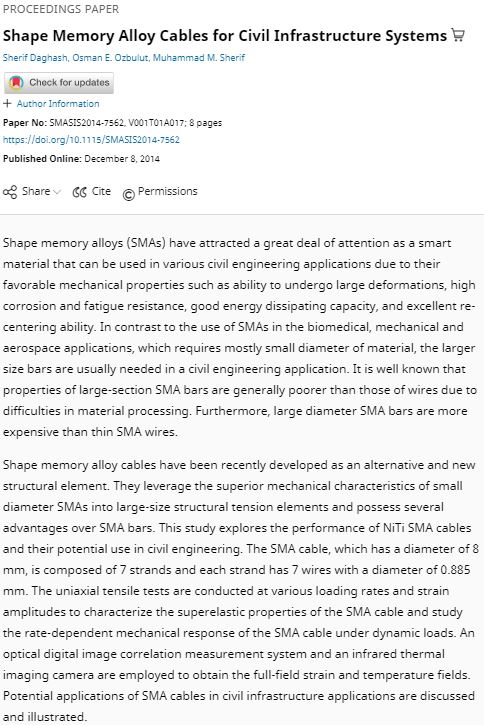
| |
Shape Memory Alloy Cables for Civil Infrastructure Systems
Sherif Daghash , Osman E. Ozbulut , Muhammad M. Sherif*
Shape memory alloys (SMAs) have attracted a great deal of attention as a smart material that can be used in various civil engineering applications due to their favorable mechanical properties such as ability to undergo large deformations, high corrosion and fatigue resistance, good energy dissipating capacity, and excellent re-centering ability. In contrast to the use of SMAs in the biomedical, mechanical and aerospace applications, which requires mostly small diameter of material, the larger size bars are usually needed in a civil engineering application. It is well known that properties of large-section SMA bars are generally poorer than those of wires due to difficulties in material processing. Furthermore, large diameter SMA bars are more expensive than thin SMA wires. Shape memory alloy cables have been recently developed as an alternative and new structural element. They leverage the superior mechanical characteristics of small diameter SMAs into large-size structural tension … Details
|
8
|
08 Dec 2014
|   |
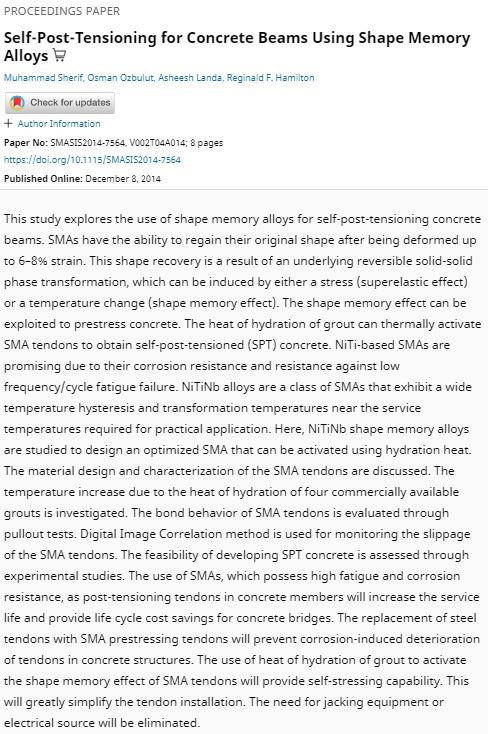
| |
Self-Post-Tensioning for Concrete Beams Using Shape Memory Alloys
Muhammad Sherif*, Osman Ozbulut, Asheesh Landa, Reginald F Hamilton
This study explores the use of shape memory alloys for self-post-tensioning concrete beams. SMAs have the ability to regain their original shape after being deformed up to 6–8% strain. This shape recovery is a result of an underlying reversible solid-solid phase transformation, which can be induced by either a stress (superelastic effect) or a temperature change (shape memory effect). The shape memory effect can be exploited to prestress concrete. The heat of hydration of grout can thermally activate SMA tendons to obtain self-post-tensioned (SPT) concrete. NiTi-based SMAs are promising due to their corrosion resistance and resistance against low frequency/cycle fatigue failure. NiTiNb alloys are a class of SMAs that exhibit a wide temperature hysteresis and transformation temperatures near the service temperatures required for practical application. Here, NiTiNb shape memory alloys are studied to design an optimized SMA that can be activated using hydration heat. The material design and… Details
|
7
|
08 Dec 2014
|   |